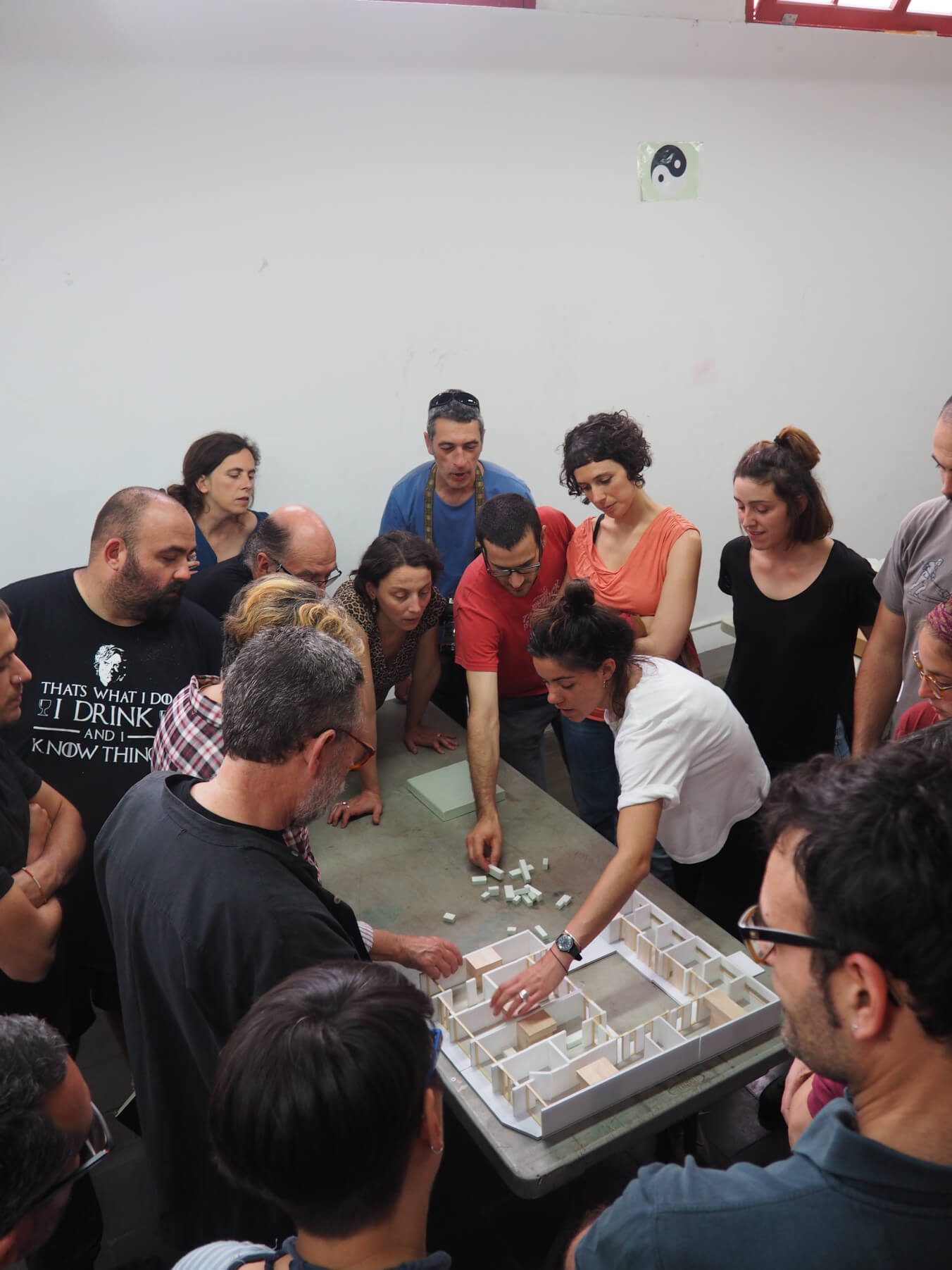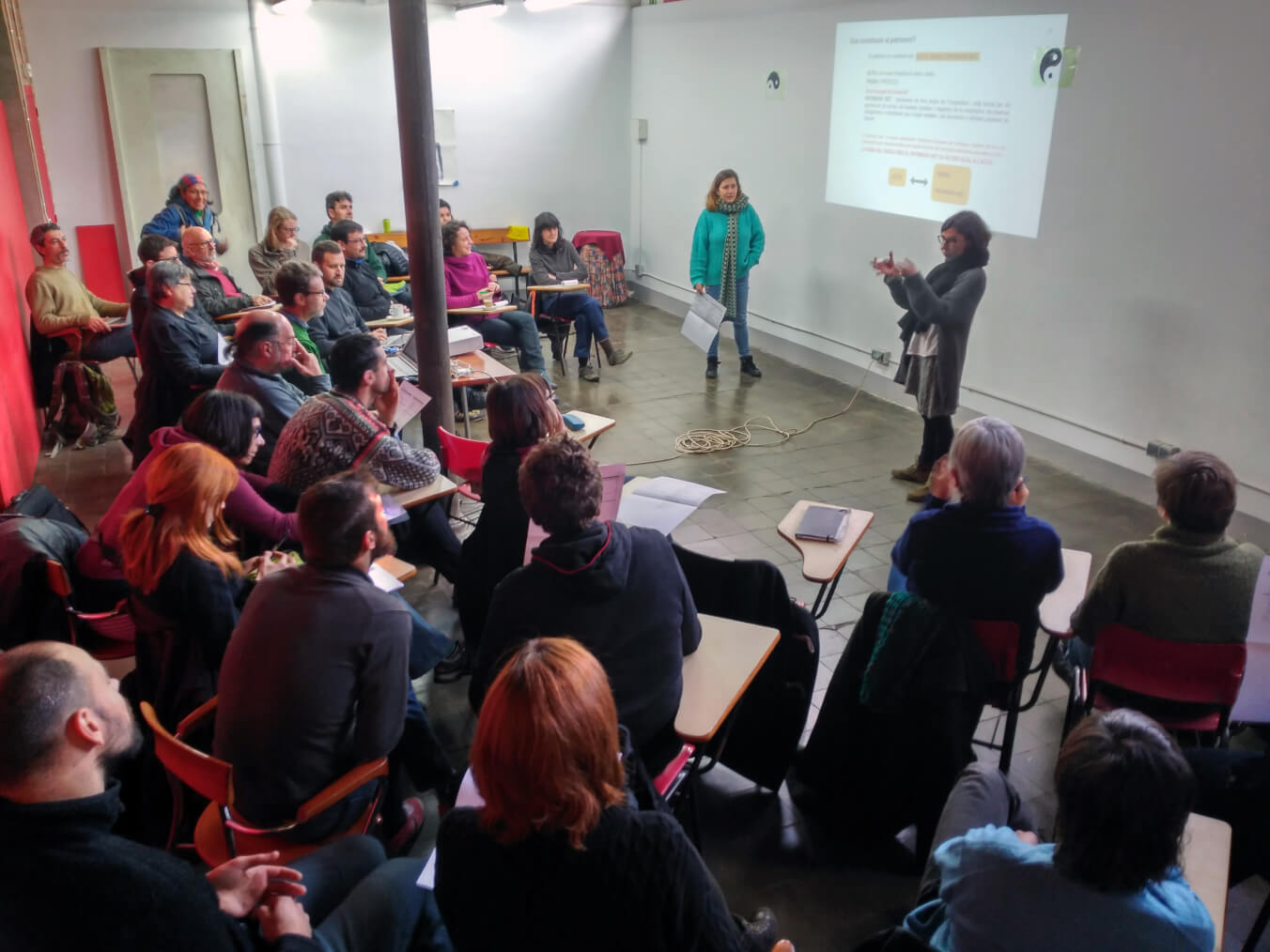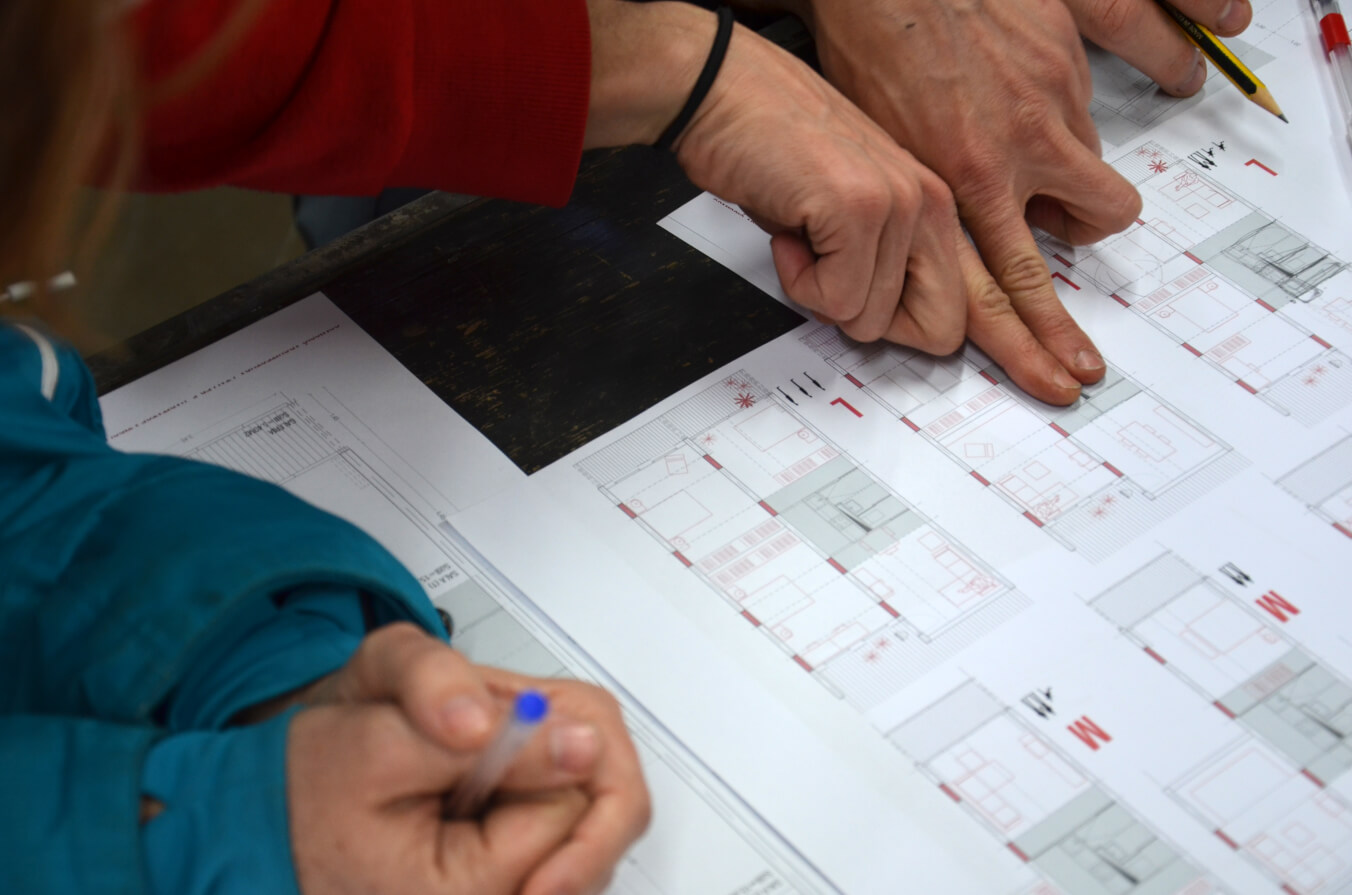Problem
A condition for the success of building projects is that the utilisation requirements are well recorded in order to achieve a high level of user satisfaction and to avoid planning errors and the associated follow-up costs. Traditionally, the planning tasks are defined by the client, which are then translated into a functional and spatial concept by the planning architects. In the last two decades, many people have become more interested in living in projects with a social-ecological orientation and in contributing their knowledge of the living world to the planning process (Stadt Wien 2017, p. 8). This is associated with complex and often heterogeneous planning requirements and it usually leads to a higher planning effort when clients and users participate more in the conception, planning and implementation of the living environments that affect them. How are participation processes effectively designed and how can any conflicting goals that may arise be successfully managed?
Generic Description
Participatory planning refers to the involvement of various stakeholders in the planning process. It enables and promotes the participation of future users in development and decision-making processes (Stadt Luzern 2020, p. 6). The focus here is not on the legal opportunities for participation, but on complementary, voluntary forms in which people without formal participation opportunities, such as children, can also be involved.
The process of participation involves various steps, usually with a sequence of events and interactions with stakeholders that build on each other (Stadt Luzern 2020, p. 20). Depending on the scope for shaping and decision-making, different levels of participation can be distinguished (participation ladder according to Sherry Arnstein 1969). A frequently used model of the participation ladder distinguishes four participation levels (SenStadtUm 2012, p. 28 f. after Lüttringhausen 2000, p. 66 ff.):
1. information: interested and affected parties are invited to find out about a planned project and to be informed about its effects.
2. participation (consultation): Interested and affected parties can inform themselves and also comment on the plans presented. They are given the opportunity to contribute ideas for implementation, but cannot decide on the content.
3. co-decision (cooperation): Those affected and interested can have a say in the development of projects. Together with those responsible, goals can be negotiated and their execution and implementation planned. Interested parties have a very great influence on the planned measures and can very strongly contribute their opinions, wishes and needs.
4. decision-making (up to self-government): Citizens (residents, administration and others) jointly make a binding decision that is legitimised by many.
For participatory planning to be successful, the following principles must be taken into account: the presence of people affected, voluntary participation, comprehensibility and transparency, binding nature and reliability, opportunities to exert influence and rules, openness to results and acting at eye level (Stadt Luzern 2020, p. 10). The process can be launched as an initiative from the population (bottom-up) or from politics or administration (top-down) (Stadt Luzern 2020, p. 12). Bottom-up initiatives often have a lasting effect on the cityscape and urban planning due to a stronger lived social togetherness (Stadt Wien 2017, p. 8).
Depending on the planning task, participation goal, planning scale and composition of the actors, there are a variety of participation procedures for implementation, such as charrette, open space conferences, planning for real, world café, future workshop or future conference (Nanz & Fritsche 2012, p. 36 ff). The composition of the stakeholders to be involved results from the dimension of the planning task. In the case of architectural projects, these are usually the future residents in addition to the clients and planners. When it comes to neighbourhood development, it is the citizens living in the neighbourhood and also institutional representatives, e.g. from public administrations, schools or companies.
Communication between those involved must be planned and coordinated from the very beginning, as it is an essential factor for the success of participatory planning. In this context, a target group and method-specific preparation of information, the integration of different ideas via workshops, models or simulation games as well as a precise planning of the communication processes are important (Stadt Luzern 2020, p. 23). Diverging goals as well as incomplete or disturbed communication processes are cause for conflicts in participation processes. These can be managed through mediation or other conflict-resolving procedures.
In recent years, various forms of eParticipation have been developed, i.e. electronic, internet-based procedures that help to involve stakeholders in decision-making processes (BBSR 2017, BBSR 2020). Depending on the planning task, face-to-face and online formats can also be combined.
Example
The Sargfabrik was created through an intensive participation process of all members and stands under the motto ‘Living, Culture and Integration’. In more than 10 years of planning work, the ‘Verein für Integrative Lebensgestaltung’ (VIL), founded especially for the building project, acted as developer, operator, landlord and owner and represented the interests of the users, who are also members of the association (similar to a cooperative), in the planning process (BMVBS and BBSR 2009, p. 90). The association actively sought to include inclusive elements. At that time, the stakeholders asked themselves what impact participation had on the planning process. In the process, which continued for several years, rough scenarios were first developed and then discussed (Stadt Wien 2017, p. 35). Basic principles and proposals for upcoming decisions were developed in individual working groups and evaluated in the subsequent decision-making processes of the group, first through consensus building and later through majority decisions. Such a process requires responsible acting members, but has the potential to illuminate the respective problem from different sides through intensive discussions and the need for argumentative justification. This made the decisions resilient in the further course (BMVBS and BBSR 2009, p. 92-93). The members of the association are active in various working groups on a voluntary basis and are thus part of the building’s processes (BMVBS and BBSR 2009, p. 91).
The project was legally declared a residential home to allow for special planning intentions. This made a more flexible floor plan design possible than was usual in socially subsidised housing, it was possible to realise tenancy rights instead of ownership rights for the residents, and cost savings could be achieved by reducing the number of required parking spaces (BMVBS and BBSR 2009, p. 92). The experiences from the Sargfabrik project were transferred by the association to the subsequent project ‘Miss Sargfabrik’.


Lessons learned and synergies
Participation, meaning taking part, participating and being involved, has many meanings depending on the discipline: Activating and empowering people, political, cultural and social participation, appropriation and public discussion of one’s own needs, or participation in works of art. In building projects, the participation of future users enables needs-based planning and creates a stronger identification of the users with their project and the neighbourhood (Stadt Wien 2017, p. 8). Participation in planning processes can go far beyond the mere involvement of citizens: A more passive conception is that of participation, while participation in its active meaning stands for participation. Thus, participation can be seen as a democratisation of planning, as formulated by Ottokar Uhl, for example (Stadt Wien 2017, p. 6). Decisions are made on the basis of different design variants and scenarios that are developed in an iterative process (see, among others, Hofmann 2014). This means approaching the solution step by step through multiple repetition and adaptation. In this way, ideas and changes can be incorporated during the ongoing (design) process. The result of the participatory planning process is a flexible and sustainable architecture with, for example, different types of flats ranging from small studios to family and large residential communities (see Hunziker Areal), adapted to the needs of the future residents and can even lead to the development of new structural typologies such as cluster flats.
Projects planned in a participatory manner gain in quality, can motivate more commitment and can be implemented more quickly if participation is carefully implemented, as increased acceptance results in fewer objections, resistance and thus delays (Stadt Luzern 2020, p. 6). The involvement of different actors leads to a stronger identification of the users with the project. The experiences and knowledge of different perspectives can result in synergies, be collected and used for further participatory planning.
Sources
BBSR (Hg.) (2017): Die Weisheit der Vielen. Bürgerbeteiligung im digitalen Zeitalter. Herausgegeben vom Bundesinstitut für Bau-, Stadt- und Raumforschung (BBSR), Bonn. Accessed on 26.04.2021 from https://www.bbsr.bund.de/BBSR/DE/veroeffentlichungen/sonderveroeffentlichungen/2017/smart-cities-buergerbeteiligung-dl.pdf?__blob=publicationFile&v=2
BBSR (Hg.) (2020):Digitale Tools für die kollaborative Entwicklung von Smart City Strategien. Herausgegeben vom Bundesinstitut für Bau-, Stadt- und Raumforschung (BBSR), BBSR-Online-Publikation Nr. 10/2020, Bonn. Accessed on 26.04.2021 from https://www.bbsr.bund.de/BBSR/DE/veroeffentlichungen/bbsr-online/2020/bbsr-online-10-2020-dl.pdf?__blob=publicationFile&v=2
BMVBS und BBSR (Hg.) (2009): Stadtquartiere für Jung und Alt – Europäische Fallstudien. Sondergutachten im Rahmen des Experimentellen Wohnungs- und Städtebaus Forschungsfeld „Innovationen für familien- und altengerechte Stadtquartiere“. Bearbeitung Universität Stuttgart Städtebau-Institut, Fachgebiet Grundlagen der Orts- und Regionalplanung Prof. Dr. Johann Jessen (Projektleitung). Herausgegeben vom Bundesministerium für Verkehr, Bau und Stadtentwicklung (BMVBS) und dem Bundesinstitut für Bau-, Stadt- und Raumforschung (BBSR), Bonn. Accessed on 26.04.2021 from https://d-nb.info/1000128016/34
Genossenschaft Kalkbreite (o.J.): Wohnen mit Kindern. Accessed on 26.04.2021 from https://www.kalkbreite.net/kalkbreite/wohnen-kalkbreite/wohnen-mit-kindern/
Hofmann, Susanne (2014): Partizipation macht Architektur: die Baupiloten – Methode und Projekte. Berlin: Jovis Verlag.
Nanz, Patrizia; Fritsche, Miriam (2012): Handbuch Bürgerbeteiligung. Verfahren und Akteure, Chancen und Grenzen. Schriftenreihe der Bundeszentrale für politische Bildung Bonn Bd. 1200 – Bonn. Accessed on 15.05.2022 from https://www.bpb.de/system/files/dokument_pdf/Handbuch_Buergerbeteiligung.pdf
SenStadtUm (2012): Handbuch zur Partizipation. Herausgegeben von der Senatsverwaltung für Stadtentwicklung und Umwelt Berlin. Projektbegleitgruppe „Handbuch Partizipation“: Dr. Jochen Hucke, Sibylle Krönert, Carsten Lilie, Ursula Renker, Sieglinde Krabs, Kurt Nelius, Dr. Peter Fleischmann, unter Mitarbeit von Zine Eddine Hathat, Claudia Ladewig und Sandra Rosenow. 2. Auflage Februar 2012.
Accessed on 26.04.2021 from https://www.stadtentwicklung.berlin.de/soziale_stadt/partizipation/download/Handbuch_Partizipation.pdf
Stadt Luzern (2020): Partizipative Planungsprozesse – Leitfaden. Luzern: Stadt Luzern.Stadt Wien (2017): Stadt der Zukunft – über partizipatives Bauen. Dokumentation einer Gesprächsreihe. Herausgegeben von der Stadt Wien, MA 18 – Stadtentwicklung und Stadtplanung, Gesamtkoordination: Wolfgang Dvorak.
Accessed on 28.04.2021 from https://www.wien.gv.at/stadtentwicklung/studien/pdf/b008510.pdf
